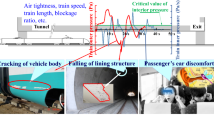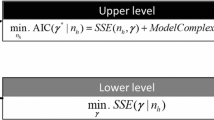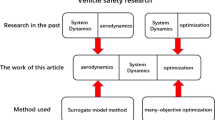Abstract
For the firing accuracy problem of the moving tank with different speed and different road level, the modelling and optimization method of the projectile disturbances of the moving tank under the general driving conditions were studied. A high-dimensional multi-objective optimization method for the projectile disturbances of the moving tank considering the different driving conditions was proposed based on the sequential approximate optimization method. Therein, a projectile disturbance multi-disciplinary simulation model of the moving tank considering multiple nonlinear factors was built and the sliced Latin hypercube design method was introduced to apply the experimental design. On the basis, the BP neural network surrogate model of the projectile disturbances at muzzle-exit of the moving tank under the general driving conditions was established. With the genetic algorithm and the potential optimal criterion, the sample points were updated to improve the accuracy of the surrogate model during the optimization. The optimization results show that the projectile disturbances at muzzle-exit of the moving tank under the general driving conditions were reduced effectively, and the comprehensive firing accuracy of the moving tank was improved. The research can provide a reference for realizing the reasonable match between firing accuracy and mobility of the tank.
Similar content being viewed by others
References
A. K. Thoutam, S. S. Nuli and T. M. Arun, Design of gas gun barrel support structure by finite element model updating using optimization techniques, Materials Today Proceedings, 22(4) (2020) 3027–3036.
S. Kim and J. Kim, Optimal design of a coil gun projectile by analyzing the drag coefficient and electromagnetic force on the projectile, Journal of Mechanical Science and Technology, 34(7) (2020) 2903–2911.
E. İsmail and A. K. Mehmet, Optimization of a passive vibration absorber for a barrel using the genetic algorithm, Expert Systems with Applications, 42(2) (2015) 894–905.
R. Kantrowitz and M. M. Neumann, Some real analysis behind optimization of projectile motion, Mediterranean Journal of Mathematics, 11(4) (2014) 1081–1097.
R. Kantrowitz and M. M. Neumann, Optimization of projectile motion under air resistance quadratic in speed, Mediterranean Journal of Mathematics, 14(1) (2017) 9.
Y. D. Xu and L. F. Qian, Multi-objective optimization of composite barrel based on the improved non-dominated sorting genetic algorithm, Acta Armamentarii, 27(4) (2006) 617–621.
N. Ahmed, R. D. Brown and A. Hameed, Finite element modelling and simulation of gun dynamics using “ANSYS”, 10th International Conference on Computer Modelling and Simulation, Cambridge (2008) 18–22.
L. Q. Wang, G. L. Yang and H. Xiao, Interval optimization for structural dynamic responses of an artillery system under uncertainty, Engineering Optimization, 52(2) (2020) 343–366.
A. A. Chojaczyk, A. P. Teixeira, L. C. Neves and J. B. Cardoso, Review and application of artificial neural networks models in reliability analysis of steel structures, Structural Safety, 52 (2015) 78–89.
F. A. Essa, E. M. Abd and A. H. Elsheikh, An enhanced productivity prediction model of active solar still using artificial neural network and Harris Hawks optimizer, Applied Thermal Engineering, 170 (2020) 115020.
A. K. Mehmet, E. Smail and Ç. Yusuf, Tip deflection determination of a barrel for the effect of an accelerating projectile before firing using finite element and artificial neural network combined algorithm, Latin American Journal of Solids and Structures, 13(10) (2016) 1968–1995.
C. J. Liang, G. L. Yang and X. F. Wang, Structural dynamics optimization of gun based on neural networks and genetic algorithms, Acta Armamentarii, 36(5) (2015) 789–794.
H. Xiao, G. L. Yang and Q. Z. Sun, Research on flexible multi-body dynamics structure optimization of artilleries, Acta Armamentarii, 38(1) (2017) 27–34.
H. Xiao, G. L. Yang and J. L. Ge, Surrogate-based multi-objective optimization of firing accuracy and firing stability for a towed artillery, Journal of Vibroengineering, 19(1) (2017) 290–301.
Y. Chen, G. L. Yang and Q. Z. Sun, Launching dynamic analysis for tank on the move based on dynamic simulation, Journal of Vibroengineering, 21(2) (2019) 472–482.
Y. Chen, G. L. Yang, Y. C. Fu and Q. Z. Sun, Dynamic simulation on nonlinear vibration of moving tank gun under high mobility conditions, Acta Armamentarii, 40(7) (2019) 1339–1348.
F. Hu, Z. P. Wu, D. H. Wang and W. H. Zhang, Sequential approximate optimization method, Journal of National University of Defense Technology, 39(1) (2017) 92–101.
P. Qian, Sliced Latin hypercube designs, Journal of the American Statistical Association, 107(497) (2012) 393–399.
K. Peng, F. Hu, W. H. Zhang and Z. P. Wu, Sequential approximate optimization method and its application in rapid design of rocket shape, Journal of National University of Defense Technology, 38(1) (2016) 129–136.
M. Farina and P. Amato, On the optimal solution definition for many-criteria optimization problems, 2002 Annual Meeting of the North American Fuzzy Information Processing Society, New Orleans (2002) 232–238.
Y. Chen, G. L. Yang and Q. Z. Sun, Dynamic simulation on vibration control of the moving tank gun based on adaptive robust control, Journal of Low Frequency Noise Vibration and Active Control, 39(2) (2020) 416–434.
Z. F. Bai and Y. Zhao, A hybrid contact force model of revolute joint with clearance for planar; mechanical systems, International Journal of Non-Linear Mechanics, 48(48) (2013) 15–36.
F. F. Liu, X. T. Rui, H. L. Yu, J. S. Zhang and J. J. Gu, Influence of barrels’ flexibility on the launch dynamics of tank during moving fire, Journal of Vibration and Shock, 35 (2016) 58–63+96.
B. F. Hao, H. Y. Wang, Q. Rui and Q. L. Wang, Dynamic modeling and model test verification of tank multi-body systems, China Mechanical Engineering, 29 (2018) 429–433.
L. M. Zhang, Model and Application of Artificial Neural Network, Fudan University Press (1993).
Acknowledgments
This work was supported by the National Natural Science Foundation of China (grant number 11572158, 51705253).
Author information
Authors and Affiliations
Corresponding author
Additional information
Recommended by Editor No-cheol Park
Yu Chen is a Lecturer of the School of Mechanical Engineering, Jiangsu University of Science and Technology, Zhenjiang, China. He received his Ph.D. in Nanjing University of Science and Technology. His research interests include numerical simulation, vibration and control, and dynamics analysis.
Rights and permissions
About this article
Cite this article
Chen, Y., Yang, G., Zhou, H. et al. Sequential approximate optimization on projectile disturbances of the moving tank based on BP neural network. J Mech Sci Technol 35, 935–944 (2021). https://doi.org/10.1007/s12206-021-0206-z
Received:
Revised:
Accepted:
Published:
Issue Date:
DOI: https://doi.org/10.1007/s12206-021-0206-z




